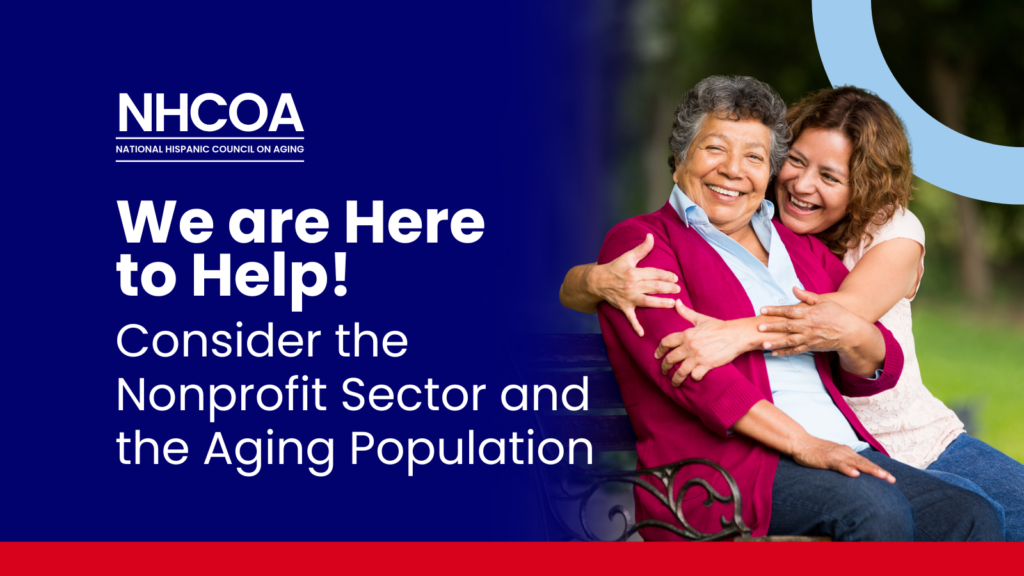
During a time of transition in the United States, The National Hispanic Council on Aging is reasserting our commitment to improving the lives of Hispanic older adults, their families, and caregivers. We wish to remind the public of the importance in aiding the aging population, and ensuring that they are living in good health, with dignity and comfort.
If there aren’t many older adults in your life, it’s easy to forget that they make up a vast portion of the United States population. According to the U.S. Census Bureau, the older adult population reached 55.8 million in 2020, which is about 16.8% of the total population. Between 2010 and 2020, we saw an increase of 15.5 million older adults in the United States, the largest 10-year numeric gain on record.
With 16.8% of the population being 65 years and older, a number that will continue to increase, we owe it to our elders, and our future selves, to ensure that older adults receive the services they need. That means improving Social Security and Medicare.
Did you know that 86% of older adults participate in Social Security? Or that 93% participate in Medicare? That’s the vast majority of older adults!
If you didn’t already know, Social Security is how many older adults maintain financial security once they retire. When you are no longer able to work, Social Security provides a source of income, the amount of which is informed by your pre-retirement income and lifetime earnings.
Medicare is public healthcare that most older adults are automatically enrolled in upon reaching retirement age. For a more comprehensive overview of Medicare, follow this link to our previous blog post on the subject: “Get to Know Medicare.”
That programs are available to our older adult population has been a reassurance to us all for almost a century, but they are far from perfect. Basing Social Security benefits off of one’s earnings throughout their career is an inherently biased, and arguably punitive approach to caring for older adults. The socioeconomic context of the United States is informed entirely by our capitalistic sense of competition, much to the detriment of our lowest-earning workers. An older adult can have worked steadily throughout their entire life, with no gaps in their employment, and then still struggle to make ends-meet in their retirement, simply due to their choice (or lack thereof) of occupation.
Recently, Medicare has seen improvements to be more affordable for its recipients. This is a step in the right direction, but our older adult population still faces adversity.
The problems with policies that inform the United States’ social services are precisely the reason that so many non-profit organizations like NHCOA exist. The nonprofit sector provides more safety nets to catch those who fall through the holes in the federal safety nets.
Did you know that there are currently over 5 million Hispanic/Latino older adults in the United States? The National Hispanic Council on Aging exists to help these older adults find security in the United States, where policy has yet to account for the intricacies of Hispanic/Latino communities. We encourage all to adopt the mindset and mission of organizations like NHCOA, who declare that the older adult population will not be someone else’s problem. Older adults deserve proper recognition as a demographic in need of specific understanding. Such understanding should be reflected in the policies aimed to help them, but until such a time it is up to communities and the non-profit sector to empower older adults and make the change we want to see.
If you or someone you know is curious about resources available to older adults, please text via Whatsapp, the NHCOA Resource Center at 202-658-8664. A multilingual hub that educates and empowers the Hispanic/Latino community with accurate information and resources to help you stay healthy. It connects you to services such as: housing, food banks, vaccines (helps you schedule vaccination appointments, find nearby vaccination centres, and provides information about vaccines, including the #RiskLessDoMore campaign), and more!
If you are curious about other organizations looking out for specific demographics of older adults, please follow the links below:
– The Diverse Elders Coalition
– NAPCA (National Asian Pacific Center on Aging)
– NCBA (National Caucus and Center on Black Aging, Inc.)
– NICOA (National Indian Council on Aging)
– SAGE (Advocacy and Services for LGBT Elders)
– SEARAC (Southeast Asian Resource Center)
References:
– Caplan, Zoe. “U.S. Older Population […],” The United States Census Bureau. 05/25/2023. https://www.census.gov/library/stories/2023/05/2020-census-united-states-older-population-grew.html
– Giefer, Katherine G. and King, Michael D. “One in Six Older Americans […],” The United States Census Bureau. 10/28/2021. https://www.census.gov/library/stories/2021/10/what-happens-when-older-adults-struggle-to-make-ends-meet.html

Recent Comments